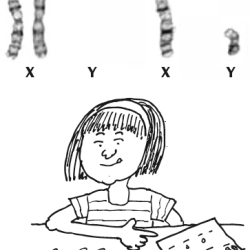Source Institutions
Source Institutions
Add to list Go to activity
Activity link broken? See if it's at the internet archive

In this activity (on pages 22-33), learners do the kind of work genetic scientists do, sorting and comparing (images of) genetic material strands called chromosomes. First, learners use two meters of thread to represent the length of DNA in a cell. Then, using a special chart called a karyotype, learners sort the genetic material of three babies based on the size and pattern of each chromosome. The introductory "What We Know" section introduces the concepts of genes, chromosomes, and genetic science.
- 5 to 10 minutes
- 45 to 60 minutes
- 1 cent - $1 per group of students
- Ages 8 - 14
- Activity
- English, Spanish
Quick Guide
Materials List (per group of students)
- tape
- scissors
- colored pencil
- thread 2 meters long (6 feet)
- pencil
- 1 copy of Baby’s Chromosomes (p. 28)
Subjects
-
Life Sciences
-
Cells
- Cell Structure and Function
- Cell Division
-
Heredity and Genetics
- Human Genetics
- DNA Structure and Function
-
Cells
Audience
To use this activity, learners need to:
- see
- read
- touch
Learning styles supported:
- Involves teamwork and communication skills
- Uses STEM to solve real-world problems
- Involves hands-on or lab activities
Designed specifically for
- Rural dweller
Culture, ethnicity, and gender
-
Girls
- Explicity developed for this group
Other
Foreign language versions of this resource:
Components that are part of this resource:
Includes alignment to state and/or national standards:
This resource is part of:
Access Rights:
- Free access
By:
Source Collection
- Science After School Consumer's Guide
Rights:
- All rights reserved, University of Nebraska State Museum and Nebraska 4-H, 2002
Funding Sources:
- National Science Foundation Informal Science Education Program, 9909496
- Howard Hughes Medical Institute
